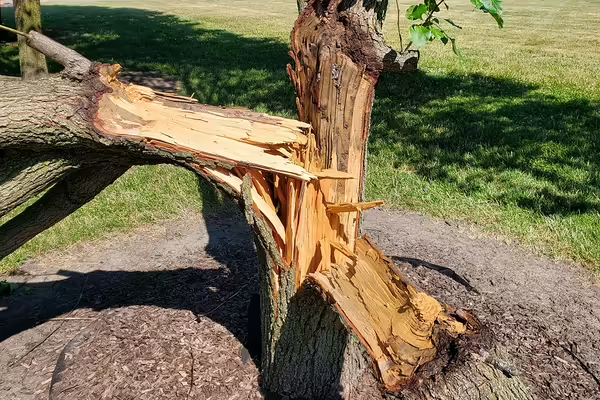
URBANA, Ill. — High winds during summer storms wreak havoc on trees. Tree defects increase the likelihood of failure, and those close to homes can quickly become dangerous. Learn to look for these weak points to be better prepared for severe weather events.
Trees experience damage from pests and disease, natural disasters, and human interference. Early stressors such as being planted too deeply, inadequate water during establishment, or forgotten stakes and guy wires contribute to a tree’s decline. Young and mature trees in urban forests often suffer drought, soil compaction, herbicide damage, overfertilization, or improper pruning practices that hinder wound closure.
Over time, the decline escalates other defects, increasing the potential for danger. For resources, review the USDA Forest Service’s manual and reach out to the local Extension office for materials and programs on proper planting, establishment, pruning, and integrated pest management methods to promote long-term health. Recognizing tree defects, preventing further damage, and relying on arborists for accurate risk assessment ensure the safety of persons and property.
Could my tree be hazardous? Is the tree close to a potential target, like a house, driveway, or play equipment? What is the age and condition of the tree? Has it been showing signs of stress like dieback, dropping limbs, less foliage each spring, or stunted leaves? These are indicators of tree stress.
Know what is normal for the species. Some species have naturally lighter green foliage that may be mistaken for illness. Some tree species are poor self-pruners, leaving dead but relatively harmless branches in the crown.
Look for root issues. Shallow root systems, damaged and decayed roots, and restricted root space severely impact root function. Stem girdling roots are another common but serious issue. Additionally, root collars buried with soil and mulch cause bark deterioration and impact the tree’s vascular system. These impacts may appear suddenly or take years to become evident. A sparse crown or isolated section of the affected canopy can often be traced to root problems.
Examine the trunk. Cracks are weak areas that occur from bending or twisting, growth expansion, frost cracking, bark inclusion, or as an effect of stem girdling roots. Immediate action is warranted if two or more cracks occur in the same area or splits through the bark extend into the wood of the tree.
Cankers are areas where the bark is sunken, swollen, flattened, cracked, dead, or absent. These develop from wounds or disease. If a canker incorporates more than half the stem’s circumference, immediate action is recommended.
Decay doesn't always mean the tree is a hazard, but decaying trees are more likely to fail. Advanced decay like soft and crumbly wood, cavities with missing wood, or fungal growth, as seen in research from University of Maryland Extension, all indicate a higher risk for failure. Arborists are trained to evaluate the safety of decaying trees.
University of Florida horticulture research shows Codominant stems occur when two or more upright branches grow closely together. These can form "included bark" or "ingrown bark" that acts as a wedge to split branches apart. Callery pear, among other negative attributes, are notorious for their upright growth habit with included bark defects that frequently fail in high winds. Maple, ash, and elm are other species that commonly form codominant stems.
Remove dead branches or dead trees immediately, regardless of season. Because it is dry and brittle, dead wood doesn't bend like live wood and is more prone to snapping in high winds. Dead branches remaining in the crown are particularly alarming as they are already partly or fully detached.
Multiple defects may occur simultaneously in trees. It is rarely one issue causing decline or failure, but more often, a combination. Regular tree checkups alleviate risk and prevent problems, especially in trees already suffering issues. It's also important to observe trees after a weather event to determine if further damage was suffered or existing problems advanced.
For more information on trees and assessing tree defects, connect with the local Extension office at go.illinois.edu/ExtensionOffice.
WRITER: Sarah Vogel is an Illinois Extension horticulture educator for DeWitt, Macon, and Piatt counties. Gardeners Corner is a quarterly newsletter from gardening experts around the state. Each issue highlights best practices that will make your houseplants, landscape, or garden shine in any season. Join the Gardener’s Corner email list at go.illinois.edu/GCsubscribe for direct access to timely tips.
PHOTO ACCESS: The photo in this article is available to download for media use. Photo by Sarah Vogel.
Illinois Extension leads public outreach for University of Illinois by translating research into action plans that allow Illinois families, businesses, and community leaders to solve problems, make informed decisions, and adapt to changes and opportunities. Illinois Extension is part of the University of Illinois Urbana-Champaign College of Agricultural, Consumer and Environmental Sciences.